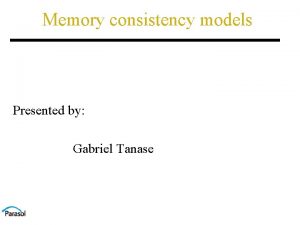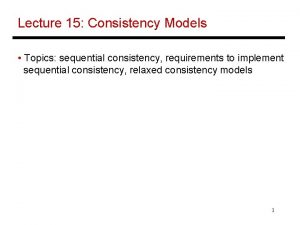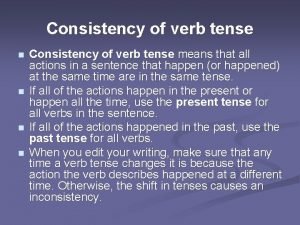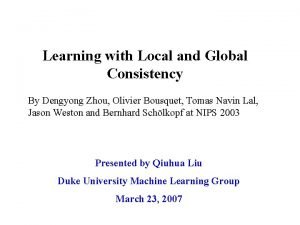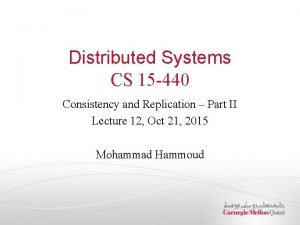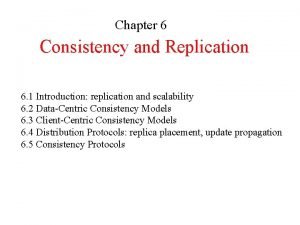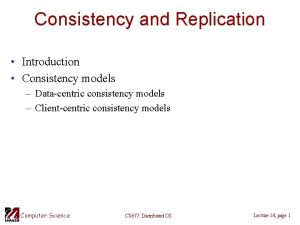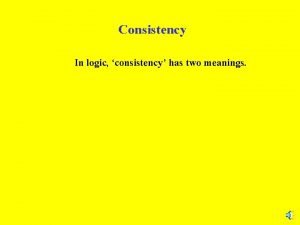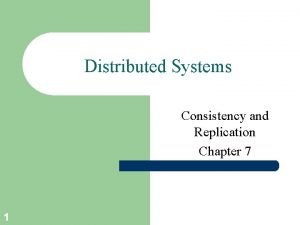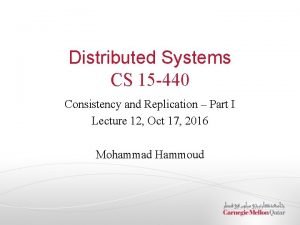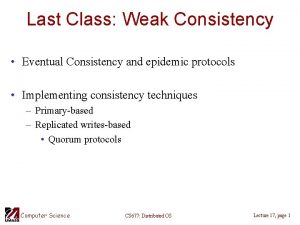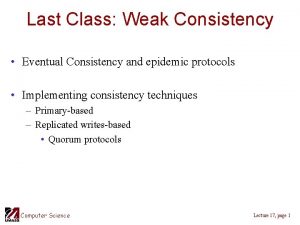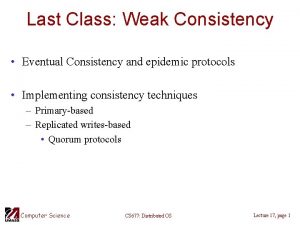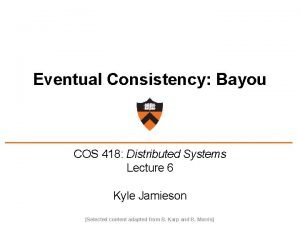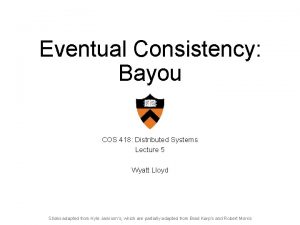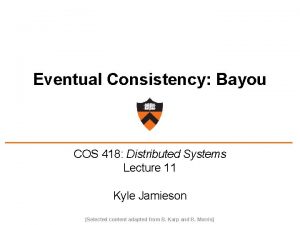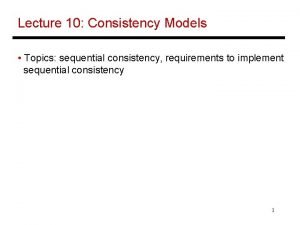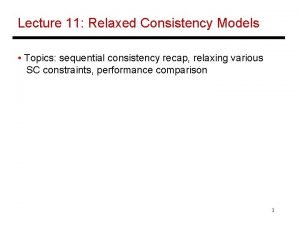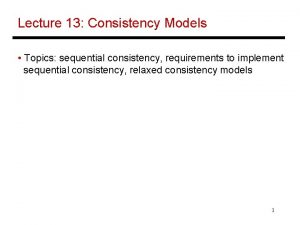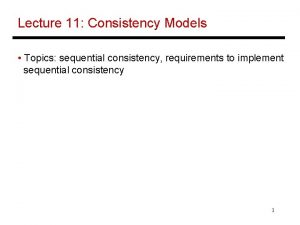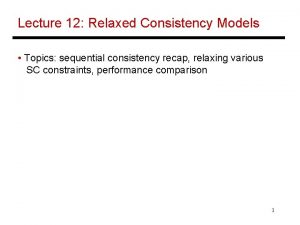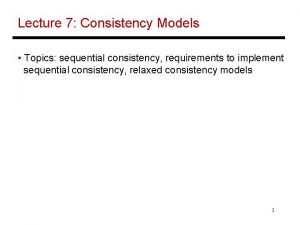Eventual Consistency Jinyang Sequential consistency Sequential consistency properties


















![Tra [Cox, Josephson] • What are Tra’s novel properties? – Easy to compress storage Tra [Cox, Josephson] • What are Tra’s novel properties? – Easy to compress storage](https://slidetodoc.com/presentation_image_h2/e3b25e05521b892b6d555157fac97935/image-19.jpg)


















- Slides: 37

Eventual Consistency Jinyang

Sequential consistency • Sequential consistency properties: – Latest read must see latest write • Handles caching – All writes are applied in a single order • Handles concurrent writes • Realizing sequential consistency: – Reads/writes from a single node execute one at a time – All reads/writes to address X must be ordered by one memory/storage module responsible for X

Realizing sequential consistency )1 (A W Cache or replica I id l a nv , e t a ) B ( R W (B ) 3 W (A )2 Cache Or replica

Disadvantages of sequential consistency • Requires highly available connections – Lots of chatter between clients/servers • Not suitable for certain scenarios: – Disconnected clients (e. g. your laptop) – Apps might prefer potential inconsistency to loss of availability

Why (not) eventual consistency? • Support disconnected operations – Better to read a stale value than nothing – Better to save writes somewhere than nothing • Potentially anomalous application behavior – Stale reads and conflicting writes…

Operating w/o total connectivity Sync w/ server resolves non-conflicting changes, reports conflicting ones to user W(A)1 W(A)2 replica Client writes to its local replica No sync between clients

Pair-wise synchronization Pair-wise sync resolves non-conflicting changes, reports conflicting ones to users W(A)1 replica W(B)3 replica W(A)2 replica

Examples usages? • File synchronizers – One user, many gadgets

File synchronizer • Goal 1. All replica contents eventually become identical 2. No lost updates – Do not replace new version with old ones

Prevent lost updates • Detect if updates were sequential – If so, replace old version with new one – If not, detect conflict • “Optimistic” vs. “Pessimistic” – Eventual Consistency: Let updates happen, worry about whether they can be serialized later – Sequential Consistency: Updates cannot take effect unless they are serialized first

How to prevent lost updates? W(f)a H 1 f mtime: 15648 W(f)b f 16679 W(f)c H 2 12354 f 15648 23657 • Strawman: use mtime to decide which version should replace the other • Problem w/ wallclock: cannot detect disagreement on ordering

Strawman fix W(f)a H 1: 15648 W(f)b H 1: 15648 H 1: 16679 W(f)c H 1: 15648 H 2: 23657 • Carry the entire modification history • If history X is a prefix of Y, Y is newer

Compress version history W(f)a H 1: 1 W(f)b H 1: 2 H 1: 1 H 1: 2 W(f)c H 2 H 1: 1 H 1: 2 implies H 1: 1, so we only need one number per host H 1: 2 H 1: 1 H 1: 2 H 2: 1

Compare vector timestamp H 1: 1 H 2: 3 H 3: 2 < < H 1: 1 H 2: 5 H 3: 7 H 1: 2 H 2: 1 H 3: 7

Using vector timestamp W(f)a H 1: 1 W(f)b H 1: 2 W(f)c H 2 H 1: 1 H 1: 2 H 1: 1 H 2: 1

Using vector timestamp W(f)a H 1: 1 W(f)b H 1: 2 W(f)c H 2 H 1: 1 H 2: 1

How to deal w/ conflicts? • Easy: mailboxes w/ two different set of messages • Medium: changes to different lines of a C source file • Hard: changes to same line of a C source file • After conflict resolution, what should the vector timestamp be?

What about file deletion? • Can we forget about the vector timestamp for deleted files? • Simple solution: treat deletion as a write – Conflicts involving a deleted file is easy • Downside: – Need to remember vector timestamp for deleted files indefinitely
![Tra Cox Josephson What are Tras novel properties Easy to compress storage Tra [Cox, Josephson] • What are Tra’s novel properties? – Easy to compress storage](https://slidetodoc.com/presentation_image_h2/e3b25e05521b892b6d555157fac97935/image-19.jpg)
Tra [Cox, Josephson] • What are Tra’s novel properties? – Easy to compress storage of vector timestamps – No need to check every file’s version vector during sync – Allows partial sync of subtrees – No need to keep timestamp for deleted files forever

Tra’s key technique • Two vector timestamps: 1. One represents modification time – Tracks what a host has 2. One represents synchronization time – Tracks what a host knows • Sync time implies no modification happens since mod time H 1: 1 H 2: 5 H 3: 7 H 1: 10 H 2: 20 H 3: 25

Using sync time W(f 1)a H 1 H 2 H 1: 1 f 1 H 1: 1 H 2: 0 W(f 2)b H 1: 2 f 2 H 1: 2 H 2: 0 H 1: 1 f 1 H 1: 0 H 1: 2 H 2: 0 f 2 H 1: 0 H 1: 2 H 2: 0

Compress mtime and synctime • dir synctime = element-wise min of child sync times • dir mtime = element-wise max of child mod times • Sync(d 1 d 1’) – Skip d 1 if mtime of d 1 is less than synctime of d 1’ • Can we achieve this with single mtime? – Skip d 1 if mtime of d 1 is less than mtime of d 1’

Synctime enables partial synchronization • Directory d 1 contains f 1 and f 2, suppose host sync a subtree (d 1/f 1) – With synctime+mtime: synctime of d 1 does not change. Mtime of d 1 increases – With mtime only: Mtime of d 1 increases • Host later syncs subtree d 1/f 2 – With synctime+mtime: will pull in modifications in e 2 because synctime of d 1 is smaller – With mtime only: skips d 1 because mtime is high enough

Using sync time W(f 1)a f 1 H 1: 1 f 2 H 1: 2 d H 1: 0 H 2: 0 only H 1: 1 f 2 H 1: 0 f 1 H 1: 0 H 1: 2 H 1: 0 H 2: 0 c f 2 Syn H 2 only H 1: 2 d H 1: 2 H 2: 0 c f 1 Syn H 1 W(f 2)b f 1 H 1: 1 f 2 H 1: 2 d H 1: 2 H 2: 0

How to deal w/ deletion W(f 1)a H 1 f 1 H 1: 1 D(f 2) f 2 H 1: 2 H 2: 0 Deletion notice for a deleted file contains its sync time d H 1: 2 H 2: 0 H 2 H 1: 1 f 2 H 1: 0 f 1 H 1: 0 H 1: 2 d H 1: 2 H 1: 0 H 2: 0

How to deal w/ deletion W(f 1)a H 1 f 1 H 1: 1 D(f 2) f 2 H 1: 2 H 2: 0 Deletion notice for a deleted file contains its sync time d H 1: 2 H 2: 0 H 2 f 1 H 1: 0 f 2 H 2: 1 f 1 H 1: 1 f 2 H 2: 1 H 1: 0 d H 1: 0 H 2: 1 H 1: 2 d H 1: 2 H 2: 1

Another definition of eventual consistency • Eventual consistency (Tra) – All replica contents are eventually identical – Do not care about individual writes, just overwrite old replica w/ new one • Eventual consistency (Bayou) – Writes are eventually applied in total order – Reads might not see most recent writes in total order

Bayou Write log Version Vector 0: 0 1: 0 2: 0 N 1 0: 0 1: 0 2: 0 N 0 0: 0 1: 0 2: 0 N 2

Bayou propagation 1: 1 W(x) Write log 1: 0 W(x) 2: 0 W(y) 3: 0 W(z) N 0 Version Vector 0: 3 1: 0 2: 0 0: 0 1: 1 2: 0 N 1 1: 0 W(x) 2: 0 W(y) 3: 0 W(z) 0: 3 1: 0 2: 0 0: 0 1: 0 2: 0 N 2

Bayou propagation Write log 1: 0 W(x) 2: 0 W(y) 3: 0 W(z) N 0 Version Vector 0: 3 1: 0 2: 0 1: 0 W(x) 1: 1 W(x) 2: 0 W(y) 3: 0 W(z) N 1 1: 1 W(x) 0: 3 1: 4 2: 0 0: 0 1: 0 2: 0 N 2

Bayou propagation Write log N 0 1: 0 W(x) 1: 1 W(x) 2: 0 W(y) 3: 0 W(z) Version Vector N 1 1: 0 W(x) 1: 1 W(x) 2: 0 W(y) 3: 0 W(z) 0: 3 1: 4 2: 0 0: 4 1: 4 2: 0 Which portion of The log is stable? 0: 0 1: 0 2: 0 N 2

Bayou propagation Write log N 0 1: 0 W(x) 1: 1 W(x) 2: 0 W(y) 3: 0 W(z) Version Vector N 1 1: 0 W(x) 1: 1 W(x) 2: 0 W(y) 3: 0 W(z) 0: 3 1: 4 2: 0 0: 4 1: 4 2: 0 N 2 1: 0 W(x) 1: 1 W(x) 2: 0 W(y) 3: 0 W(z) 0: 3 1: 4 2: 5

Bayou propagation Write log N 0 1: 0 W(x) 1: 1 W(x) 2: 0 W(y) 3: 0 W(z) Version Vector N 1 0: 4 1: 4 2: 0 1: 0 W(x) 1: 1 W(x) 2: 0 W(y) 3: 0 W(z) 0: 3 1: 6 2: 5 0: 3 1: 4 2: 5 N 2 1: 0 W(x) 1: 1 W(x) 2: 0 W(y) 3: 0 W(z) 0: 4 1: 4 2: 5

Bayou uses a primary to commit a total order • Why is it important to make log stable? – Stable writes can be committed – Stable portion of the log can be truncated • Problem: If any node is offline, the stable portion of all logs stops growing • Bayou’s solution: – – A designated primary defines a total commit order Primary assigns CSNs (commit-seq-no) Any write with a known CSN is stable All stable writes are ordered before tentative writes

Bayou propagation ∞: 1: 1 W(x) Write log 1: 1: 0 W(x) 2: 2: 0 W(y) 3: 3: 0 W(z) Version Vector 0: 3 1: 0 2: 0 0: 0 1: 1 2: 0 N 1 ∞: 1: 1 W(x) N 0 0: 0 1: 1 2: 0 0: 0 1: 0 2: 0 N 2

Bayou propagation ∞: 1: 1 W(x) Write log 1: 1: 0 W(x) 2: 2: 0 W(y) 3: 3: 0 W(z) N 0 4: 1: 1 W(x) Version Vector 0: 4 1: 1 2: 0 0: 0 1: 1 2: 0 N 1 1: 1: 0 W(x) 2: 2: 0 W(y) 3: 3: 0 W(z) 4: 1: 1 W(x) 0: 4 1: 1 2: 0 0: 0 1: 0 2: 0 N 2

Bayou’s limitations • Primary cannot fail • Server creation & retirement makes node. ID grow arbitrarily long • Anomalous behaviors for apps? – Calendar app
 Acid vs base
Acid vs base Dolo direto
Dolo direto Memory consistency
Memory consistency Extensive and intensive examples
Extensive and intensive examples Physical property and chemical property
Physical property and chemical property Consistency
Consistency Inconsistent verb tense
Inconsistent verb tense Product consistency example
Product consistency example Verb consistency
Verb consistency Strict consistency
Strict consistency Verb consistency
Verb consistency Learning with local and global consistency
Learning with local and global consistency Processor consistency model
Processor consistency model Konsep consistency pada property acid dari sql transaction
Konsep consistency pada property acid dari sql transaction Mobile identity consistency
Mobile identity consistency Consistency is the last refuge of the unimaginative
Consistency is the last refuge of the unimaginative Consistency limits in geotechnical engineering
Consistency limits in geotechnical engineering Building internally consistent compensation system
Building internally consistent compensation system Consistency is king for employee engagement
Consistency is king for employee engagement Continuous consistency in distributed system
Continuous consistency in distributed system Logical entailment examples
Logical entailment examples Explain data centric consistency model
Explain data centric consistency model Explain data centric consistency model
Explain data centric consistency model Causal consistency in distributed system
Causal consistency in distributed system Logic consistent
Logic consistent Strict consistency
Strict consistency Verb consistency
Verb consistency Consistency is an underappreciated
Consistency is an underappreciated Overall consistency
Overall consistency Nache design
Nache design Csp sudoku
Csp sudoku Goods-services continuum
Goods-services continuum Distributed shared memory architecture tutorialspoint
Distributed shared memory architecture tutorialspoint Consistency and replication in distributed systems
Consistency and replication in distributed systems Continuous consistency in distributed system
Continuous consistency in distributed system Interview questions
Interview questions A sales representative wishes to survey
A sales representative wishes to survey A reduced stock with a jelly like consistency
A reduced stock with a jelly like consistency


